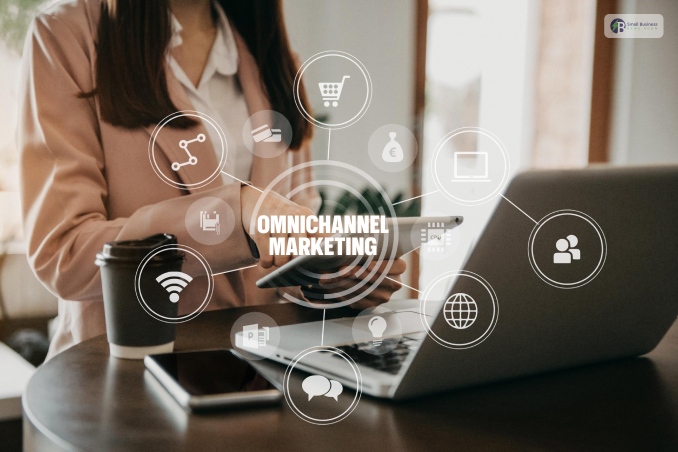Table Of Contents
- What is Omnichannel Marketing?
- The evolution of the marketing channels
- 1. Single-Channel Marketing
- 2. Multichannel Marketing
- 3. Omnichannel Marketing
- Why It Matters in Today’s Competitive Landscape?
- 1. It Meets Sky-High Customer Expectations
- 2. It Drives Loyalty And Lifetime Value
- 3. It Boosts Sales And ROI
- 4. It Offers Extremely Helpful Customer Insights
- Would You Like To Upgrade Your Strategy?
- Understanding The Difference Between Omnichannel And Multichannel Marketing
- What Are The Key Components Of An Omnichannel Strategy
- Data Sharing
- Customer Journey Mapping
- Personalization And Segmentation
- Consistency In Brand Messaging
- Benefits Of Omnichannel Marketing For Businesses
- How To Create An Omnichannel Marketing Strategy
- Step 1: Identify Your Ideal Customer And Chart Their Journey
- Step 2: Channel Integration And Unified Data
- Step 3: Seamless And Personalized Communication
- Step 4: Use Data Analytics To Optimize Performance
- Step 5: Monitor And Adjust Strategy
- Common Omnichannel Marketing Mistakes To Avoid
- Future Of Omnichannel Marketing: Trends To Watch
What Is Omnichannel Marketing? A Complete Guide to Strategy, Benefits & Best Practices
In today’s fast-paced digital world, establishing a connection with customers has become more complex and necessary than ever! You might have a hard the term “omnichannel marketing” being thrown around lately.
It is not any sort of buzzword! It is more like a fundamental shift in how modern businesses approach the customer journey.
In this blog, I am going to break down what omni-channel marketing is, how we got there, and why this specific marketing approach is necessary for businesses to stay ahead in the competition.
What is Omnichannel Marketing?

At its core, omnichannel marketing is a strategy strongly focused on creating a highly unified and personalised customer experience across all channels and devices.
Just think about it! A customer might browse all your products on your mobile application during their commute.
While searching, they might save a few items to their wishlist and receive a personalised email later that evening. Who knows? They might even get a discount on those items?
These help them decide so they can later visit the store and make the purchase as per their wants/needs.
In the true omnichannel world, all these interactions are well-connected. The store associate would instantly know which items have been wishlisted. Based on that, they can further apply the same to the email discount right at the register.
Additionally, they store this entire interaction and are connected.
What is the key difference from traditional marketing? Omnichannel marketing opportunities put customers at the center, not just the channel.
Every single platform, from your website as well as social media to email, as well as the physical stores. These work together in perfect harmony.
The evolution of the marketing channels
To understand where you are actually going, it is also necessary to know where you have been!
1. Single-Channel Marketing
In the past, a business might have only a physical store or a direct-mail catalog. It was easy, but it also limited the market.
2. Multichannel Marketing
The Internet, social media, and mobile apps have made businesses’ communication through different channels widespread. The downside?
They were most of the time separated and independent. Your website team was not communicating with your in-store squad, leading to frustrating, disjointed customer experiences.
3. Omnichannel Marketing
It is the present-day solution. It clarifies that. The message and information flow are continuous throughout the customer journey and experience, making it free and delightful.
Why It Matters in Today’s Competitive Landscape?
In a market overwhelmed with alternatives, the customer experience is the most potent differentiator of all. Gaining mastery of omnichannel marketing is the only way out because:
1. It Meets Sky-High Customer Expectations
The present-day consumer expects nothing less than convenience and personalization from the seller.
When a customer calls for support, they expect you to know what they were just browsing online.
Not providing this smooth experience is a very fast way for the competitor who is doing it better to take away your customers.
2. It Drives Loyalty And Lifetime Value
When you make the process easy and treat the customers as if you really understand them, they are there for the long haul.
It is a fact that customers from the omnichannel play have a higher retention rate and a lifetime value that is significantly higher than that of single-channel shoppers. Happy customers tell others and bring in new customers.
3. It Boosts Sales And ROI
United strategies are simply the ones that work best. Numerous studies have shown that omnichannel customers tend to spend more per transaction and over time.
By making the buying process less cumbersome, you not only increase the chances of sale but also get a better return on your marketing investment (ROI).
4. It Offers Extremely Helpful Customer Insights
By integrating data from all contact points, you gain a strong, comprehensive view of your audience.
You can track their journey from awareness of your product to purchase, understand their problems, and customize future interactions based on actual behavior rather than guesswork.
Would You Like To Upgrade Your Strategy?
Omnichannel marketing is not merely a plus point; it is a necessity for the business. It is a way to fortify customer ties, keep up with the competition, and achieve growth that is not just temporary but sustainable.
We will explore in depth the tactics, tools, and strategies you need to direct a truly coordinated and impactful customer journey. It’s time to make your customer experience memorable!
Understanding The Difference Between Omnichannel And Multichannel Marketing
Now that we have observed what omnichannel marketing is, it is time ot know about the differences between the omnichannel and multichannel marketing!
The key differences between omnichannel and multichannel marketing lie in the level of integration, which is central to the strategy.
The multichannel mainly uses multiple independent channels! This helps them to maximise the reach.
On the other hand, omnichannel integration brings together all channels to create a unified, seamless, and more customer-centric experience.
| Aspect | Multichannel Marketing | Omnichannel Marketing |
|---|---|---|
| Primary Focus | This is channel-centric or product-centric. The aim is for a broader reach and brand awareness. | Customer-centric approach, prioritizing a seamless, personalized customer journey. |
| Channel Integration | The channels can operate independently with minimal or no data sharing. | All the channels, such as websites, applications, physical stores, social media, and email, are integrated and work further together. |
| Customer Experience | This approach can be disjointed and fragmented. However, the context is often lost if a customer switches channels. | This is consistent, cohesive, and seamless. It allows the customer to transition between touchpoints effortlessly. |
| Data Management | The data is separated within each channel. This makes a difficult holistic view of the customer. | Data is collected and unified in a single platform, such as a CDP or CRM. This helps create a single, comprehensive customer view. |
| Personalization | The personalization is very channel-specific, such as an email campaign with an offer. | Here, the personalization is hyper-individualised. It is further consistent across all channels based on the complete history and behavior of the customers. |
| Execution Effort | This is a simple and much faster to implement. It comes with lower costs, and you do not need complex technological integration. | Here, it requires a significant investment in technology, data integration, and cross-departmental coordination. |
What Are The Key Components Of An Omnichannel Strategy

An omnichannel approach integrates all channels for a consistent customer experience. The main parts of the cohesive strategy are:
Data Sharing
One important factor is strong data integration that ensures customer data (buying habits and likes) is updated across all points of contact.
Moreover, employees across all channels thus have a single, 360-degree view of the customer, helping eliminate the information silos so often seen in multi-channel systems.
Customer Journey Mapping
This technique visualizes the entire customer journey across multiple channels. It takes mapping to identify both the obstacles and the best moments to interact.
This helps ensure that online, mobile, and physical store experiences are seamlessly connected.
Personalization And Segmentation
By pulling data from all sources, the company can segment its customers and offer each group targeted content and product suggestions.
This marketing method, based on each customer’s unique needs, not only makes customers feel valued but also enhances the overall experience.
Consistency In Brand Messaging
By maintaining a consistent brand voice, style, and visuals across channels, it assures customers that the brand is trustworthy and is gradually shaping its identity, no matter where they interact with it.
All these factors combined produce a single, customer-centered ecosystem that not only attracts but also retains customers.
Benefits Of Omnichannel Marketing For Businesses
Omnichannel marketing aims to provide customers with a seamless, smooth experience. The benefits are noticeable in three areas: online, offline, and mobile. The following are the primary benefits:
The improved customer experience and satisfaction: A seamless, frictionless journey means customers do not have to re-enter their information every time they use a different interaction channel (e.g., the app, store pickup, etc.). An integrated experience increases customer satisfaction.
Increased engagement and loyalty: Businesses build stronger relationships and greater trust by providing personalized, consistent interactions.
Omnichannel customers are usually more active and exhibit greater long-term loyalty.
Better insights and analytics: Data from all touchpoints is being integrated, providing a single, unified view of customer behavior. In the end, businesses can get a deeper, data-driven understanding of customers’ likes and dislikes and do less guesswork when making decisions.
Higher conversion rates and sales: A smoother customer journey is equivalent to eliminating purchase obstacles, and personalization will encourage the customer to take action.
Omnichannel customers are considered to have a higher lifetime value and make more purchases than single-channel customers, thereby increasing overall revenue.
How To Create An Omnichannel Marketing Strategy

To successfully implement an omnichannel marketing strategy with real impact, you need the right approach: focusing on the customer and integrating all the online and offline touchpoints to deliver a seamless single-brand experience.
Step 1: Identify Your Ideal Customer And Chart Their Journey
By diving deep into data from customer interactions, you can customize both the preferences and the behaviors.
Creating extremely detailed personas and customer journey maps will help you identify key moments of engagement and points of customer frustration.
Example: Sephora collects data on activities, both online and in-store, through its Beauty Insider program to customize offers.
Step 2: Channel Integration And Unified Data
Do away with the restrictions that separate departments to achieve a complete, 360-degree customer view.
Introduce a centralized CRM or Customer Data Platform to enable syncing online and offline data.
Example: By connecting its app and stores, Starbucks provides a seamless platform for mobile ordering, payments, and loyalty rewards.
Step 3: Seamless And Personalized Communication
Keep the branding visually consistent across all channels while simultaneously customizing content with AI and cross-channel support.
Example: Nike recommends products based on user behavior, collects fitness data, and allows in-app store reservations for a hassle-free experience.
Step 4: Use Data Analytics To Optimize Performance
Put your main KPIs —such as CLV, conversion rates, and CSAT —under the microscope. Different attribution models should also be considered alongside customer comments for improvement.
Example: Target utilizes data from both its website and app to optimize fulfillment and customer interactions.
Step 5: Monitor And Adjust Strategy
Be prudent in your tactics and, at the same time, open to new technologies such as AI and AR—work on being ready for the future rather than focusing on the short term.
Example: Disney continuously updates its My Disney Experience app to improve guest journeys .
Common Omnichannel Marketing Mistakes To Avoid
As companies implement an omnichannel strategy, they often fall into several common pitfalls. They need to be aware of these mistakes so they do not fail.
Lack of Data Integration: The biggest mistake of all is failing to link data from all channels. When there is no centralized Customer Data Platform (CDP) or CRM, businesses lose the opportunity to provide a single customer view, which in turn leads to disconnected, inconsistent experiences.
Thus, to be safe from this, one needs to procure technology that does not put data into different silos.
Ignoring Customer Feedback: Sometimes, businesses get so absorbed in the technological aspect that they overlook the human factor.
Not listening to feedback from surveys, social media, and customer service calls is the same as closing your eyes to the critical issues customers experience as they move through your business. Make it a habit of asking for this feedback and acting on it in order to improve your strategy continuously.
Overcomplicating the Journey: One of the mistakes that people make is to include too many touchpoints without a clear goal.
It can confuse customers and make them feel uncomfortable. What you need to do instead is to declutter your journey and make sure every contact is worthwhile.
Failing to Personalize: Using the same treatment for all customers across all channels is a mistake. A well-planned omnichannel strategy figures out ways to use the data to personalize the interaction, offers, and content.
Utilize the information to provide the customer with an experience that fits their needs and is in line with their previous behavior.
Future Of Omnichannel Marketing: Trends To Watch
While implementing an omnichannel strategy, businesses often make a few mistakes. It is vital not to fall into these traps if one wants to be successful. The first one being,
Lack of Data Integration: One of the biggest mistakes is failing to connect data from different channels.
Without a merged Customer Data Platform (CDP) or CRM, companies cannot get a single view of the customer, leading to inconsistent and disjointed experiences. To counter this, invest in technology that connects all data sources.
Second, Ignoring Customer Feedback: Companies sometimes pay more attention to technology than to people.
Ignoring input from surveys, social media, and customer service calls means failing to recognize very important problems in the customer journey.
Always ask for this kind of feedback and also use it to improve your strategy.
Third, Overcomplicating the Journey: Adding too many touchpoints without a clear purpose is a common mistake.
This can take customers by surprise and create an annoying situation. Instead of complicating the customer’s journey, ensure that every interaction is worth it.
Lastly, Failing to Personalize: Not differentiating between customers and treating them all similarly is a wrong approach.
A good omnichannel strategy relies on data to customize the interactions, offers, and content.
Use analytics to provide experiences shaped by people’s individual preferences and past actions.














